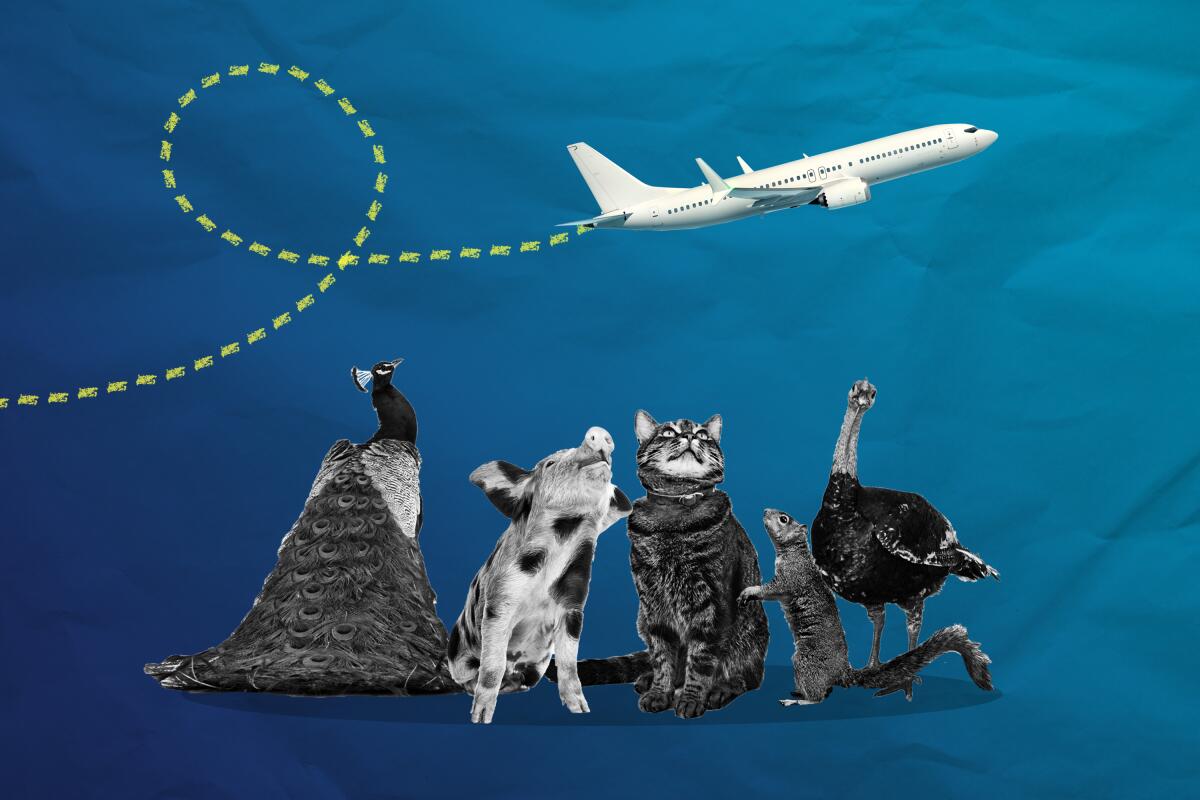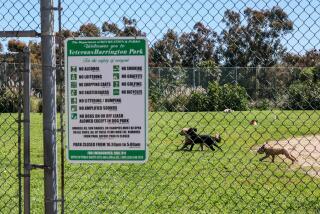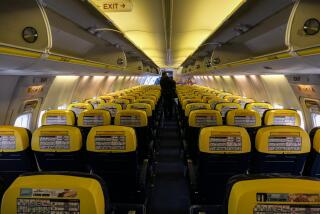Sorry, peacocks. New ruling says only dogs qualify as service animals

- Share via
On Dec. 2, the U.S. Department of Transportation ended years of mounting tension among passengers with disabilities, airlines, flight attendants and travelers. Under the agency’s Air Carrier Access Act, which prevents airlines from discriminating against passengers with disabilities, a new ruling will strip many emotional support animals, or ESAs, of their service animal designation.
Service animals, such as seeing-eye dogs, provide indispensable aid to the visually impaired. These highly trained canines guide their owners through crowds and sit patiently, if not always quietly, at the owner’s feet.
This is not necessarily the case with ESAs. Although these animals can provide emotional aid to people with psychiatric issues, they often have no formal training. An untrained animal will sometimes become stressed in the crowded, unfamiliar confines of an airplane cabin.
Because an ESA is allowed to sit at an owner’s feet, on an owner’s lap and even accompany him or her to the lavatory, dogs and even pigs (yes, pigs) have been known to defecate in common areas of the airplane cabin.
On a November 2018 flight from Atlanta to Miami, a Delta Air Lines passenger became incensed when he discovered dog feces on his pants and shoes. He had been sitting in a seat previously occupied by an ESA.
Four years earlier, a woman and her 70-pound pig were booted off a US Airways flight from Bradley International Airport in Connecticut after the swine began defecating in the aisle.
ESAs often make loud noises (they are animals, after all), sparking angry cries from passengers who expect flight attendants to stop the insanity. But how can crew members force a dog to stop barking, a cat to stop mewling or a pig to stop oinking when its owner can’t get the animal to comply?
As a flight attendant, I’ve faced this dilemma on numerous occasions. Once, on a flight from Miami to Saõ Paulo, Brazil, a first-class passenger’s emotional support dog began barking shortly after takeoff. The rhythmic woofing continued for hours. Passengers who had paid thousands of dollars for first-class seats were outraged. But there wasn’t much flight attendants could do except encourage passengers to file a complaint with the airline.
Misbehaving ESAs have growled, barked, lunged at and even bitten flight attendants and passengers. One of the worst incidents occurred in June 2017 during the boarding of a Delta flight from Atlanta to San Diego.
Passenger Marlin Jackson was mauled by an emotional support dog that had been sitting on the lap of the man seated next to him. According to the complaint reported by the Atlanta Journal-Constitution, Jackson “suffered lacerations and punctures to his face and upper body requiring 28 stitches. [He] bled so profusely that the entire row of seats had to be removed from the airplane.”
Incidents such as these have delayed flights, frightened passengers and, in Jackson’s case, caused injuries leading to lawsuits against the airline and the ESA’s owner.
What is also frustrating for airlines are the types of ESAs passengers have attempted to bring on an airplane. In July 2018, a woman caused chaos on a Frontier Airlines flight departing Orlando, Fla., for Cleveland when she was told that her emotional support squirrel did not meet ESA guidelines (rodents are not allowed). Because the woman refused to exit the plane, she and the squirrel had to be removed by police.
In January 2018, a passenger argued that her emotional support peacock should be allowed on a flight departing Newark Liberty Airport. United Airlines disagreed, refusing to allow the colorful creature onboard because of its large size.
Delta transports nearly 250,000 service and support animals annually. On its website, the airline reports an 84% increase in ESA incidents since 2016. “Customers have attempted to fly with comfort turkeys, gliding possums known as sugar gliders, snakes, spiders and more. Ignoring the true intent of existing rules governing the transport of service and support animals can be a disservice to customers who have real and documented needs.”
Herein lies the problem. Legitimate online agencies offering ESA certification require applicants to answer questions about their mental health. The answers are then forwarded to a doctor for approval. But I found online services that don’t require a doctor’s approval. For about $100, anyone can fill out a form and have their pet certified as an ESA.
Airlines have allowed passengers to bring pets aboard the airplane for decades. Pets are required to remain in portable kennels stowed beneath seats. But traveling with Scruffy is not cheap. American, United and Delta charge $125 one way for pets to fly within the U.S.
ESAs travel for free. Moreover, ESAs are not required to remain in a portable kennel. Although this may be wonderful for owners wanting in-flight animal contact, many passengers and crew feel as though they’re on an airborne version of Noah’s Ark.
The new DOT rule, which will go into effect 30 days after the date of publication in the Federal Register (this could be weeks or months from now), defines a service animal as: “A dog, regardless of breed or type, that is individually trained to do work or perform tasks for the benefit of a qualified individual with a disability, including physical, sensory, psychiatric, intellectual, or other mental disability.” Furthermore, it “allows airlines to recognize emotional support animals as pets, rather than service animals.”
No more emotional support cats out of their kennels at 30,000 feet. Air travel has gone to the dogs. The trained ones. The DOT ruling aims to keep it that way.
More to Read
Sign up for The Wild
We’ll help you find the best places to hike, bike and run, as well as the perfect silent spots for meditation and yoga.
You may occasionally receive promotional content from the Los Angeles Times.






